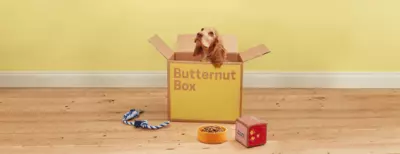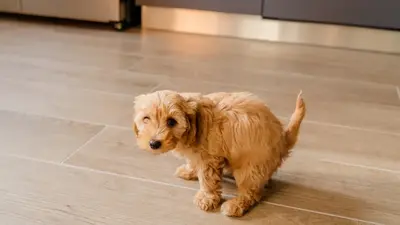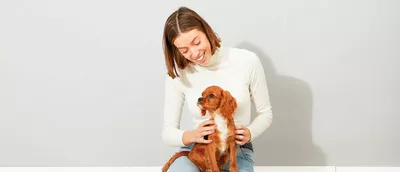How to Introduce a Puppy to a Dog
- 14 Mar 2024
- 11m read
.jpeg)
Advice from our very own Butternut Box Ambassador, Meera. Meera is an IMDT qualified Dog Trainer specialising in puppy training and socialisation, across the Sheffield area.
Tips for Introducing a Puppy to a Dog
Before I share my expert tips on how to introduce your puppy to a dog, I have to tell you something that may come as a shock to you…did you know that not all dogs like puppies?
Even though you and I know that your puppy is definitely the cutest little floofy bundle of joy to have ever walked this earth…there will be dogs who find your puppy irritating, annoying, and a pain in the proverbial. Please bear that in mind before introducing your puppy to dogs that you don’t know very well…
Having said that, you came here to find out how to safely and comfortably introduce your puppy to a dog, so let’s get started.
1.The sniff test - It’s no secret that puppies and dogs have incredibly powerful noses
When possible, you should start your introductions with scent swaps (or as I call it, sniff tests). To do this, take a blanket or toy that smells of the dog / your puppy, and ensure they each get to spend some time sniffing the item. This way your puppy gets to sniff the other dog’s scent, and vice versa.
Isn’t that a bit weird?
Maybe if we do this to new people we meet, yeah, we’d probably get a few strange looks. But absolutely not in the world our puppies and dogs live in.
Scent swapping is a fantastic way of letting them find out more information about each other - in a safe and controlled way, and without forcing introductions. This way, when they do meet each other, they will recognise the familiar scent of each other - with hopefully positive outcomes!
2. Location, location, location
Apart from being a rather excellent TV programme, location is really important when introducing your puppy to a dog. Choose neutral territory - such as a secure dog field, or a quiet area of a park.
Why is this important?
Imagine you were meeting me for puppy training for the first time. How would you feel if I let myself into your house, made myself a cup of tea, ate all your good biscuits, left crumbs all over your sofa, changed your Netflix password to something more memorable, and then left - but not before having a good nosy through your snack cupboard. It would probably be our first and last meeting, wouldn’t it?
The same principle applies to letting your puppy run riot at the other dog’s house. Without setting clear rules and safe boundaries, there’s lots of things that could go wrong - especially if your puppy starts to muscle their way into the other dog’s food, treats, personal space or toys. On neutral ground, we hopefully remove a lot of these risk factors - although I have seen puppies (not my client’s, may I add!) arguing over who gets to carry a stick home, so never say never…
3) Don’t walk so close to me…
Parallel walking is step three of introducing your puppy to another dog. Parallel walking is a skill, and it’s important to consider distance and safety when doing this. By practicing parallel walking, you can assess how the other dog feels about your puppy, at a safe distance. Introductions don’t have to be carried out at close quarters, especially to begin with. Giving your puppy and the other dog some space to decide how they feel about each other, can go a long way towards their relationship building.
Do I really have to do this? Can’t I just let them off lead in the garden and let them sort it out?
Yes, you do really have to do this if you want to give them the best chance of a successful meet. Just like we need to get to know new people before deciding whether we want to spend time with them, or whether we need to fake an emergency appointment whenever we see them, puppies and dogs need to follow this process too. Parallel walking offers safety, space and distance for them to make up their minds about each other.
4) It’s not rude, it’s just a bum sniff
If I had a penny for every time a puppy owner was embarrassed when their pup tried to sniff another dog’s bottom, I’d be relaxing on my own private island right about now (joke, I would be building a Disneyland for rescue dogs). Puppies and dogs gather so much information through scent, so letting them briefly sniff each other’s back-end is a perfectly polite way of letting them greet each other. I’d much rather see that than your puppy pawing the other dog in the face to say hello!
How do I encourage my puppy to say hi politely?
The trick is in the approach. Ideally, you want to avoid meeting the other dog head-on, as this can encourage unnatural greetings. Think about how to use the space to your advantage, so you can create a puppy-face-to-dog-bum greeting (or vice versa!)
It’s worth bearing in mind that some dogs or puppies are really sensitive about having their private areas sniffed. It’s definitely a good idea to check if the other dog is ok with this first - no matter how awkward you might feel about having that conversation. You might as well start getting used to strange conversations now you’re a puppy owner! I’ve never talked about puppy bowel movements so much in my life!
5) The slower you go, the faster your puppy will make friends
It’s really important that introductions are made slowly and positively. It’s preferable to arrange several short meets, rather than one long one, because you can then massively reduce the risk of things going wrong! Always try and end things on a positive note. That could be a fun play session for your pup, and a nice glass of wine or posh chocolates for you!
Things to Avoid When Introducing a Puppy to a Dog
Avoid punishments. If your puppy, or the other dog, are growling or barking at each other - this is communication, their way of telling us “hey I don’t really like this!” or “I dunno if I like you” and it’s our job to listen to that and take appropriate actions, we definitely should not punish them for growling or barking.
Avoid starting fights over resources. When I say resources, I mean anything that your puppy, or the other dog, may find valuable. This could include tangible things such as toys or food (including treats) but it can also include space and people. Some dogs can be quite protective over their favourite spot on the sofa, or the lap of their favourite human (I wouldn’t know about this bit, as despite being the best dog mum to my foster dog, he seemed to forget I existed whenever my partner was around?!).
Ensure there’s plenty of space for both dogs, and pick up anything that could cause a squabble before they’re due to meet each other.
Avoid Disney-like expectations. We all love a happily ever after ending, but try and manage your expectations. Don’t be disheartened if things don’t go exactly to plan - safety has to be the priority. Don’t be afraid to reach out to a qualified trainer if you’d like some help either!
How Long Does it Take for a Dog to Get Used to a New Puppy?
Honestly, it takes as long as it takes - which I appreciate might be a very disappointing answer.
Just remember that you play a huge role in how successful the interactions are - from managing the interactions, providing space and safety, to choosing the right environment, to knowing how to use rewards to build a positive relationship and reading their body language, you can influence the timeline of how long it takes for a dog to get used to your puppy. If you’re not sure how to do this, please search for a professional, qualified trainer to help you.
Do Dogs Get Jealous of New Puppies?
This is a really interesting question - and it’s made my brain hurt, as I’ve had to spend quite a bit of time reading scientific and behavioural studies to answer it (you’re welcome!)
We know that dogs can have the cognitive intelligence of a 2 - 2 ½ year old (yes, even if your puppy can’t see the treat that’s right in front of their nose, let’s give them the benefit of the doubt, ok?)
I suppose the question could be: do 2 year old children feel jealous? Or are they just a bit hostile if they don’t get their own way?
Jealousy (or proto-jealously in dogs, if we want to get technical) is not too dissimilar to hostility. This could explain why lots of puppy owners make comments like “my dog gets jealous when I come home smelling of other dogs”. In reality, it could just be that your dog is a bit offended that you’ve been cheating on them at the park.
Unfortunately, the studies I’ve been looking into don’t have a black and white answer to this question. Some studies suggest that dogs do feel proto-jealously, or envy, and other studies suggest that dogs feel insecure or threatened - which is mislabelled as jealously.
The reason why there isn’t a black and white answer, is because it’s a really complex field of study, and the research that was carried out happened under lots of different conditions, with varying results.
What Do I Do if My Dog Doesn’t Like My New Puppy?
If your dog doesn’t like your new puppy, then you should send your puppy to me (if my partner is reading this, I’m just joking). To everyone else, I’m deadly serious.
If your dog doesn’t like your new puppy, I’ve prepared a short checklist for you below.
1) Why? Is your puppy being a bit of a brat to your older dog?
I’m the eldest sibling, and I didn’t always like my sister, as she got away with things I was never allowed to get away with, yet somehow I always got blamed.
It’s important to supervise their interactions, and it is your job (not your dog’s job) to gently and positively intervene if your puppy is winding your older dog up. Remember - gently and positively, your puppy won’t be well versed in polite greetings, and they won’t have learnt much about body language and social play yet. This is what you need to be teaching them by not letting them practice terrorising your older dog.
2) Has your household dynamic changed into a two-for-one?
By that, I mean is your older dog now lumped into doing everything when your puppy does? From garden visits for the toilet, to playtime, to walks…imagine going from the only dog, to having to put up with the puppy at all hours of the day! Ensure that your resident dog still has solo access to you, as well as their favourite things and activities, so they don’t feel that the puppy is spoiling things for them.
3) Sharing is not always caring
Asking your puppy and older dog to share important things, such as food, or treats, is a recipe for disaster. Ensure they each have their own feeding stations - separate from each other. The same applies to their own bed areas. Forcing them into sharing resources may cause them to argue, which would be very unfortunate, as it can be very easily avoided. Worst case scenario, you have to go shopping for more things!
4) I probably shouldn’t have kept this for the last thing on the list, but get some help.
When I say help, I mean genuine, accredited, professional help. The internet will throw all sorts of weird advice at you (yes, I appreciate the irony after my bum-sniffing comments earlier in this article) but most of the advice will just be people’s opinions. Search for a qualified trainer who can support and guide you through the bonding process between your puppy and older dog.
Disclaimer: The information provided in this article is not intended as a substitute for an in-depth puppy consultation or bespoke training programme specifically designed to help you and your puppy. To enquire about puppy training with Meera, please visit www.meerapuppins.co.uk/contact/

.webp)


